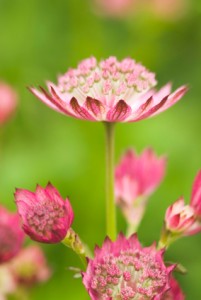Astrantia
With a name derived from the Latin word for ‘star’ (aster), Astrantia is well-known and loved for the star-like quality of its flower heads. Astrantia major, maxima and carnicolica are also known affectionately as the ‘elancholy gentleman’, ‘masterwort’ and ‘Hattie’s pincushion’.
Habitat
Astrantia has historically flourished through widespread growth in Central, Eastern and Southern Europe and the Caucasus.
Description
Growing rapidly to be about one or two feet tall in just one season, Astrantia comes in a variety of colours, ranging from green through to cream, pink and deep reddish-purple.
Astrantia’s tiny, delicate, star-shaped flower heads are held on fine stems radiating from a central point with a ruff of bracts protecting them and their seeds.
Availability
This shade-loving perennial will bloom about three months after a spring planting, or six to nine months after an autumn planting, if grown in partial shade and with adequate moisture.
Astrantia is relatively pest-free, so once its basic shade and moisture needs are taken care of, it can practically be left to its own devices.
Species
Astrantia is a genus of plants in the Apiaceae family. Ten species exist in the wild, although only about half of these can be found in the common garden.
Care Tips
Originating in the moist woodlands of Europe and Asia, Astrantia is at its happiest when in damp, heavy, regularly fertilized soil and dappled shade, jostling for space with other plants.
When planting in sunnier sites it’s important to incorporate more humus into the soil. Ensure plentiful water supply in dry conditions, especially if the plants are young.
Did you know?
Astrantia belongs to the same family as the humble carrot.
References
http://www.telegraph.co.uk/gardening/3319801/How-to-grow-Astrantia-Shaggy.html
http://en.wikipedia.org/wiki/Astrantia
http://www.bbc.co.uk/gardening/plants/plant_finder/plant_pages/8830.shtml
http://www.egarden.info/2011/02/26/astrantia-masterwort/



